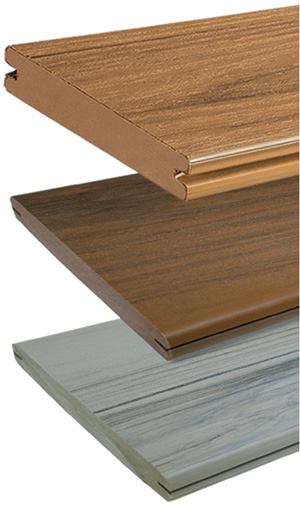Growing consumer interest in low-maintenance alternatives to traditional building materials is having a real effect on the residential decking market: By 2011, wood-plastic composites will account for almost a quarter of all residential decking sales, predicts The Freedonia Group, a Cleveland-based market research firm. That’s up from 4 percent in 1996.
As the popularity of composite decking increases, so, too, will the need for builders to familiarize themselves with the category’s expanding number of products. Each manufacturer offers a distinct blend of polymers, organic fibers, and additives, meaning that material strength, durability, and resistance to mold and fire vary widely according to brand. Some composites manage to look a lot like real wood, while others don’t come close. Some have met code test standards, but most have not. And each product has its own installation guidelines, which tend to be far more complex than those for traditional wood decking.
Pros & Cons. Composite decking manufacturers have worked hard to sell homeowners and builders on the long-term advantages of their products. Composites eliminate the expense of regular staining and annual water sealing. They don’t check or split like solid lumber, and they promise to outlast even the most rot-resistant of solid-sawn species. In addition, many makers use at least some recycled content, whether for the wood fiber, the plastic, or both—an important selling point for some consumers.
Composites have their drawbacks too. For example, many consumers have complained of a tendency to mildew, especially when the decking is installed in the shade. Manufacturers contend that any decking product would mildew in shady conditions; while that may be true, the problem has been a surprise to homeowners who believe they were promised a product that required no maintenance.
To keep decks looking good, most composite decking manufacturers recommend periodic sweeping and washing with water to keep the surface free of debris and dirt, which can support mold growth. If stains or mold do occur, the companies recommend a deck wash containing sodium hypochlorite and detergent.
In cases where the decking has been left wet and poorly maintained for extended periods, fungal decay has been reported with some composites. Fading is another issue. Composites almost always fade when exposed to sunlight, so customers should check weathered samples when choosing colors. Weathering is usually complete in three to six months, depending on exposure.
The Chemistry. Most wood-plastic composite decking products are made with polyethylene, commonly used for plastic bags and bottles and other consumer products. A smaller number are made with polypropylene, a much harder plastic, or polyvinyl chloride (PVC), also known as vinyl.
While different types of plastic have different mechanical qualities, a decking product can’t be evaluated solely by the polymer used, since the manufacturer can manipulate its mechanical properties. As Dr. Robert J. Tichy, research engineer in Washington State University’s Wood Materials and Engineering Laboratory, explains, “With the appropriate additives, you could make any polymer perform the way you want. It’s just a question of cost.”
Adding wood fiber to the composite offers several benefits. Besides being cheaper than plastic, wood tends to outperform plastic in strength, rigidity, and flammability tests. Wood experiences less thermal expansion than plastic and usually weighs less. The wood fiber also helps manufacturers more closely approximate the look of traditional wood decking. On the downside, the presence of wood fiber makes the material more porous and vulnerable to stains, and introduces the risk of mold and decay.
Chemical additives such as flame retardants and UV stabilizers can also be mixed into the formula, as can antimicrobial chemicals intended to fight mold and mildew. Each additive increases production costs.
Solid Composites. Of all the composites on the market, solid products like those from Trex Co. most closely resemble wood decking in size and thickness. But as anyone who has handled Trex knows, solid composites lack the stiffness of their sawn-lumber counterparts, typically requiring joist spacing no greater than 16 inches on center. Diagonal and commercial applications are usually limited to 12-inch spacing.
On the other hand, the material’s flexibility does offer advantages. Because it bends more easily than traditional lumber, curves and round sections are easier to incorporate.



